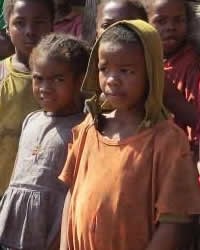Conflict for the Antaifasy people goes back as early as 1680 when problems began between them and the Antaimoro. At one point the Antaimoro took control when the Antaifasy king, Maseba liberated his people. During the 18th century Ifara became their king. He was a smart ruler whose leadership gave the Antaifasy a monopoly over trade with the Europeans and control of the Manaampatra River. The river is located in south-eastern Madagascar which flows through the Antaifasy settlements and enters the Indian Ocean near the city of Faralangans.
During the 18-19th centuries the French and British attempted to take over Madagascar causing unrest for the people. The French were unsuccessful. This was followed by the British. From 1810-1828, Radama 1, a Merina king, began efforts to unify his country with help from the British. He allowed English missionaries to spread Christianity throughout the island and transcribe the main language of the people, Malagasy, into a written form.
In 1827, the Antaifasy kingdom was invaded by the Merina army and made a vassal state of the Kingdom of Merina. Radama 1 widow, Ranavalona 1, ruled from 1828-1861. She terrorized the country for 33 years by ousting all foreigners including the Christians. She executed hundreds of political rivals. In 1852 the Merina prime minister ordered a powerful military campaign to take control of the Antaifasy people and their land. They fled to the island of Anosinandriamba, however the Merina captured the Antaifasy men, killing most of them. The women and children were taken back to lmerina as slaves. In 1861 Radama II became king of Madagascar, and he restored international relationships with the outside world and allows Christians to return to the country. He was assassinated in 1863. The Antaifasy remained resistant to Merina domination and were never fully subjugated.
In 1894 the French invaded Madagascar and by 1896 they made it their colony. Despite French colonization in 1896 and the collapse of the Merina monarchy in 1897, animosity between the Antaifasy and Merina has remained and occasionally flared up into violent conflict, as occurred in 1922, 1936 and 1990, resulting in dozens of deaths. The French gave the country its independence on June 26, 1960. The country continued to go through political instability and economic problems which affected the Antaifasy. Since 1990, they have continued to seek control or maintain their territory especially within the city Farafangana.
The Antaifasy are clever agriculturalists producing crops such as rice, vanilla and cassava. Added to this is bananas, pineapple, coconuts and especially ginger. The women are known for their beautifully embroidered cloths, dresses and other clothing. The men are outstanding at fishing and known for their wood carving. Living close to the Manaampatra River and the city of Farafangana has allowed them to become outstanding in trade and business. They are a proud and independent people who maintain a cultural closeness with each other. Government and private schooling have allowed their children to advance, and some have branched out especially in the areas of trade and commerce. Their strong tie to their religious beliefs has unified them and provides them with a strong identity, purpose and code for living.
The majority of Antaifasy hold to a traditional belief that maintains a close tie to their dead. They acknowledge there is a supreme God they call Zanahary (Creator) or Andriamanitra (Sweet, or Fragrant, Lord). The dead have been conceived as playing the role of intermediary between this supreme God and humankind and are viewed as having the power to affect their lives for good or evil. They are considered to be “gods on earth,” who have the most important role in their lives while they are alive. Great hardship or trouble can result if the dead are offended or neglected.
They place great importance on burial. Each family has a burial location, known as tanindrazana where a tomb house has been built to hold their deceased ancestors. The tomb house is expensive. It is always taken care of by the families with pride and devotion. They have spiritual diviners, healers and astrologers known as ombiasy. They depend on the ombiasies to be the intermediary connection between them and their dead relatives often using them to find answers to problems or important decision in their lives. Even a highly educated Antaifasy would not think of building a house without consulting the ombiasy for the best day to begin work. The ombiasy is paid for his services and he sells various forms of talismans to keep away evil spirits and ghosts.
Taboos are called fady, and they regulate a great deal that controls the Antaifasy's lives. An example of one of their taboos is they do not sit in the doorway of a house while the rice is sprouting, since the door of the house is compared to the "gateway" of birth. By blocking it, one might impede the "birth" of the rice.
About 20% of Antaifasy are Christian, mainly Catholic. Christianity is often mixed into their traditional spiritual beliefs and ancestral worship which are dominant among the other 80% of their people.
The greatest need for the Antaifasy people is to accept the Lord. They need to be freed from the bondages of ancestral worship, taboos, suspicions and anger towards other tribal groups, especially the Mineria.
Pray for the Antaifasy to be spiritually released from suspicions, taboos, astrology and ancestral worship.
May Antaifasy Christian believers become biblical strong and willing to reach their people for God's Kingdom.
May others see the result of God's grace in their lives.
Pray that as a people they will no longer hold hate and anger towards other people like the Mineria. May they come to having true peace!
Scripture Prayers for the Antaifasy in Madagascar.
| Profile Source: Joshua Project |










